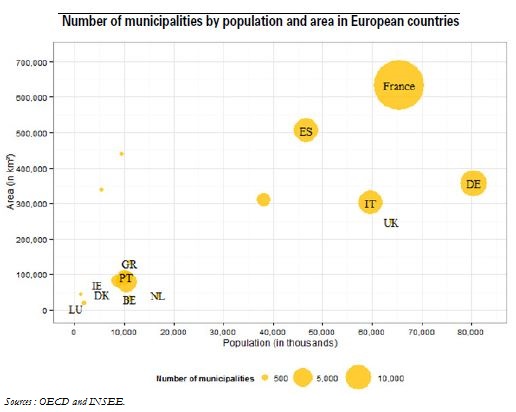Trésor-Economics No. 154 - An economic approach to local government reform
In 2014, there were 36,681 municipalities in France (36,767 including overseas municipalities), 101 départements and 27 regions. French local-government entities accounted for 40% of the European Union total in 2011.
Their economic role is substantial: local governments accounted for 21% of French government expenditure and 60% of government investment in 2014. Their powers are varied and may overlap in certain cases, particularly as a result of the clause de compétence générale (abolished by the Local Administration Reform Act (NOTRe) of 7 August 2015), and the complexity of government policy segmentation.
Since 2012, the government has embarked on a new stage of decentralisation that reorganises local governments and their powers. More specifically, metropolitan areas have been strengthened and the size and role of intermunicipal structures and regions have been increased. Local government reform has several objectives and is part of the debate about adapting our institutions to the way the French economy works. The reform better aligns the geographical boundaries of local governments with France’s economic geography, providing key tools for improving economic efficiency, while promoting adaptation to local preferences.
From an economic point of view, a metropolitan area or an intermunicipal structure, similar in scope to urban areas, would seem the appropriate level of government for exercising local powers, meaning the powers involving the day-to-day relations between economic agents. Such powers include local transport or urban planning. Metropolitan areas or intermunicipal structures should be in the best position for improving transport and housing because they can give due consideration to externalities stemming from greater concentration of activity: both the positive externalities (more interaction between agents that boosts productivity) and negative externalities (congestion). At the same time they can mitigate the negative effects of excessive fragmentation of local administration or excessive tax competition. A smaller number of local governments with more clearly defined powers would also contribute to more thorough consideration of externalities.
Furthermore, provided that they are large enough, regions appear to be the right level for establishing a local economic strategy and ensuring a coherent distribution of activity within their boundaries, especially between urban areas. As things stand (before the merger of regions on 1 January 2016), some regions are too small and sometimes their boundaries are inconsistent with economic geography. For example, some of them do not have any large metropolitan areas.
Local government reform should also make expenditure more efficient and, ultimately, produce savings through pooling of resources. The experience of other countries tends to show that municipal mergers can reduce per capita expenditure, without undermining the level of services provided.
